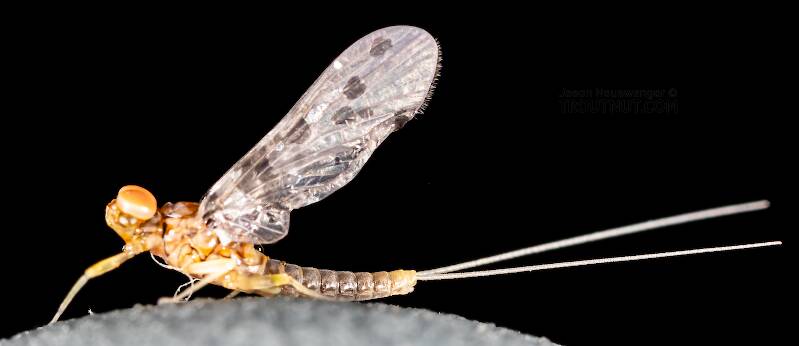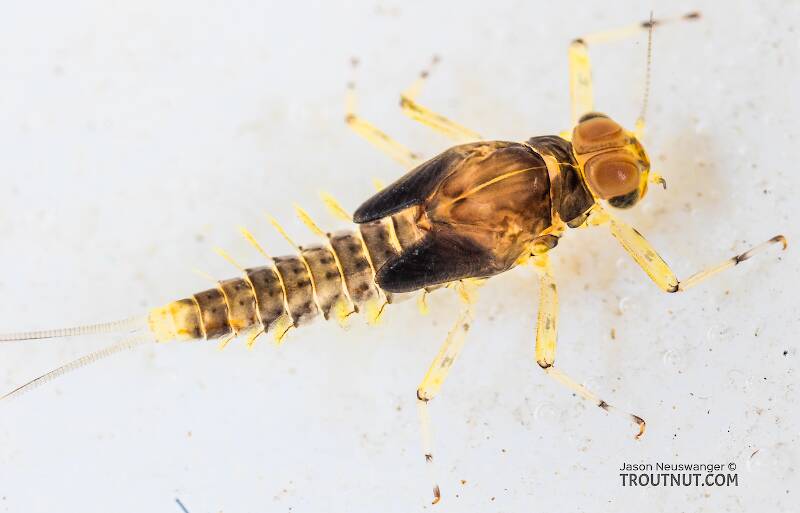
Salmonflies
Pteronarcys californica
The giant Salmonflies of the Western mountains are legendary for their proclivity to elicit consistent dry-fly action and ferocious strikes.


Mayfly Species Acentrella insignificans (Tiny Blue-Winged Olives)
Where & when
In 11 records from GBIF, adults of this species have been collected during July (45%), June (18%), May (9%), August (9%), March (9%), and September (9%).
In 61 records from GBIF, this species has been collected at elevations ranging from 2379 to 10302 ft, with an average (median) of 5151 ft.
Species Range
Physical description
Most physical descriptions on Troutnut are direct or slightly edited quotes from the original scientific sources describing or updating the species, although there may be errors in copying them to this website. Such descriptions aren't always definitive, because species often turn out to be more variable than the original describers observed. In some cases, only a single specimen was described! However, they are useful starting points.
Male Spinner
Wing length: 4 mm
Abdominal tergites 2-6 of male imago pale, semi-hyaline, considerably tinged with smoky brown; genitalia of the modified moffati type (now a synonym of Baetis tricaudatus); no costal projection on the hind wing, which has two veins only.
Turbinate eyes small, rather bright red. Thorax deep brown. The pleural sutures and the anterior projection of the metanotum are pale cream-colored. Fore femora dull smoky brown, tibiae and tarsi paler. Middle and hind legs pale ochreous, with smoky tinges on the femora. Wings hyaline, venation pale. Only two veins in the hind wing; the costal projection is entirely wanting. Hind wing narrow and leaf-like.
Abdominal segments 2-6 pale, semi-hyaline, the tergites considerably tinged with smoky brown. Segments 7-10 opaque; the tergites light sepia-brown, the sternites whitish. Tails white. The second joint of the forceps somewhat cylindrical; fourth joint of the forceps longer and narrower than in B. dardanus (now a synonym of Labiobaetis dardanus), but not as long as in B. frivolus (now a synonym of Heterocloeon frivolum). Between the bases of the forceps is a short projecting plate, not found in dardanus.
Aside from the genitalic differences noted, this species may be separated from B. dardanus by the smoky tinges of the basal abdominal tergites, which are also lacking in B. propinquus (now a synonym of Labiobaetis propinquus); B. frivolus (now a synonym of Heterocloeon frivolum) and B. amplus (now a synonym of Heterocloeon amplum) are larger, darker species of the same group.
Specimens of the Mayfly Species Acentrella insignificans
1 Male Dun

1 Nymph

Start a Discussion of Acentrella insignificans
References
- Jacobus, L. M., Wiersema, N.A., and Webb, J.M. 2014. Identification of Far Northern and Western North American Mayfly Larvae (Insecta: Ephemeroptera), North of Mexico; Version 2. Joint Aquatic Science meeting, Portland, OR. Unpublished workshop manual. 1-176.
- Needham, James G., Jay R. Traver, and Yin-Chi Hsu. 1935. The Biology of Mayflies. Comstock Publishing Company, Inc.
Mayfly Species Acentrella insignificans (Tiny Blue-Winged Olives)
Species Range
Common Names
Resources
- NatureServe
- Integrated Taxonomic Information System
- Global Biodiversity Information Facility
- Described by McDunnough (1926)

